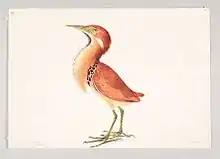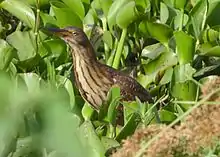Cinnamon bittern
The cinnamon bittern or chestnut bittern (Ixobrychus cinnamomeus) is a small Old World bittern, breeding in tropical and subtropical Asia from India east to China and Indonesia. It is mainly resident, but some northern birds migrate short distances.
| Cinnamon bittern | |
|---|---|
_Photograph_by_Shantanu_Kuveskar.jpg.webp) | |
| Ixobrychus cinnamomeus
from Mangaon, Maharashtra, India | |
| Scientific classification | |
| Kingdom: | Animalia |
| Phylum: | Chordata |
| Class: | Aves |
| Order: | Pelecaniformes |
| Family: | Ardeidae |
| Genus: | Ixobrychus |
| Species: | I. cinnamomeus |
| Binomial name | |
| Ixobrychus cinnamomeus (Gmelin, 1789) | |
 | |
Description

This is a small species at 38 cm (15 in) length, though it is one of the larger Ixobrychus bitterns. Possessing a short neck and longish bill, the male is uniformly cinnamon above and buff below. The female is similar but her back and crown are brown, and the juvenile is like the female but heavily streaked brown below. When surprised on its nest or concerned, it assumes the characteristic attitude of bitterns, termed the on-guard. The neck is stretched perpendicularly, bill pointing skyward, while the bird freezes and becomes very hard to see among the surrounding reeds.[2]
Distribution
The species has an extremely large range throughout Asia; there are breeding populations from India to Indonesia. Vagrants have been in Micronesia, the Seychelles and Afghanistan, among other locations. Global population estimates are uncertain and range from 130,000 to 2,000,000 individuals.[1]
Ecology

The cinnamon bittern breeds in reed beds, nesting on platforms of reeds in shrubs. Four to six eggs are laid. The species can be difficult to see, given their skulking lifestyle and reed bed habitat, but tend to emerge at dusk, when they can be seen creeping almost cat-like in search of frogs. Cinnamon bitterns feed on insects, fish and amphibians.[2]
Gallery
 Cinnamon Bittern, Van Vihar National Park, Bhopal, May 2017
Cinnamon Bittern, Van Vihar National Park, Bhopal, May 2017
References
- BirdLife International (2012). "Ixobrychus cinnamomeus". IUCN Red List of Threatened Species. 2012: e.T22697323A40256962. doi:10.2305/IUCN.UK.2012-1.RLTS.T22697323A40256962.en.
- Ali, Salim; J C Daniel (1983). The book of Indian Birds, Twelfth Centenary edition. New Delhi: Bombay Natural History Society/Oxford University Press.
Further reading
- Birds of India by Grimmett, Inskipp and Inskipp, ISBN 0-691-04910-6
